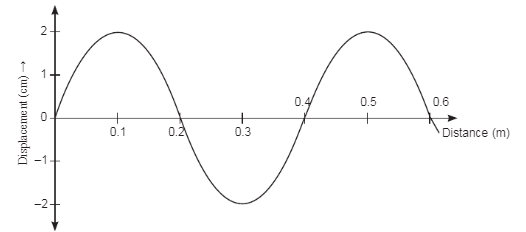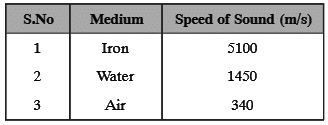Class 9 Science Chapter 11 Case Based Questions - Sound
Q1: Read the given information and answer the questions based on the passage and related studied concepts.
The propagation of a wave travelling through a medium at a velocity of 340 m/s is shown in the graph below. Find Wavelength, Frequency, Time period and Amplitude. (i) Frequency?
(i) Frequency?
Ans: Frequency = Velocity / Wavelength
= 340 m/s / 0.4
= 850 Hz
(ii) Amplitude?
Ans: Amplitude (as read from graph) = 2 cm.
(iii) Wavelength?
Ans: Wavelength: λ = distance between two consecutive crests
= 0.5 m – 0.1 m = 0.4 m
(iv) Time period?
Ans: Time period = 1 / Frequency
= 1/850
= 0.00117 s.
Q2: Read the given passage and answer the questions based on the passage and related studied concepts.
Reflected sound is called echo. Sometimes echo results in reverberation. It is not possible for us to hear an echo every-time. Bats use reflected ultrasonic squeaks from prey to detect its location. Ultrasound finds endless applications in the fields of medicine as well as industry. Ultrasound is also used in the working of SONAR. Many animals such as dogs can detect ultrasound.
(i) List two applications of ultrasound in medicine.
Ans: Ultrasound is used in medical techniques of diagnosis such as ultrasonography and echocardiography.
(ii) How is SONAR useful in defence of the country?
Ans: SONAR is used in defence of the country as it is used to detect hidden submarines of enemics in the ocean
(iii) How is echo different from reverberation?
Ans: Echo is simply reflected sound. Reverberation is the persistence of sound due to its multiple reflection.
(iv) How is ultrasound useful in industry?
Ans: Ultrasound is used to detect flaws in the metal. It is also used for cleaning of hard to reach places such as spiral tubes etc.
Q3: Speed of sound travelling through three different media at a particular temperature is given below. Observe the table and answer the following questions: (i) On what factors does speed of sound in a medium depend?
(i) On what factors does speed of sound in a medium depend?
Ans: Speed of sound in a medium depends on
- Temperature— as temperature increases, speed of sound increases.
- Speed of sound is highest in solids, lesser in liquids and least in gases
(ii) We receive heat and light from the sun but cannot hear the sound of explosions occurring on its surface. Give reason.
Ans: We do not hear the sound of explosions occurring on sun because sound waves are mechanical waves and cannot travel through vacuum/empty space.
(iii) Why is sound wave called longitudinal wave?
Ans: Sound wave is called longitudinal wave because it propagates in the form of density or pressure variations through a medium creating compressions and rarefaction
(iv) Why is sound wave called longitudinal wave?
Ans: Sound wave is called longitudinal wave because it propagates in the form of density or pressure variations through a medium creating compressions and rarefaction.



















